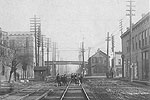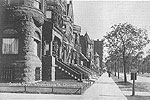
Grand Boulevard
— Washington Park (continued)
Prior to the 1890s, most of the district east of State Street
between 41st and 63rd Streets was prairie. A small community
of
Irish and German workers lived near the Rock Island Railroad
car shops, but this area, with its one- and two-story frame cottages,
had little impact on the development of Grand Boulevard-Washington
Park. Until 1889 State Street was the boundary line between the
Town of Lake and the township of Hyde Park. But long after this
section became part of Chicago, State Street continued to s symbolize
the division between the poor and the middle class. Indeed, it
is no coincidence that the public housing project known as the
Robert Taylor Homes (1960-62) was built on the site of the old
State-Dearborn-Federal slum (See Fig. 1).
The subdivision of the district between State Street and Cottage
Grove Avenue was tied to improvements in public transportation.
By 1887 cable cars were running along Cottage Grove as far as
63rd Street, supplementing the horse-drawn railway lines on
State
and Wentworth. But it was the completion of the "Alley L"
to Jackson Park for the Columbian Exposition of 1893 that spurred
the development of this part of Chicago. The elevated railroad,
with its stations at 43rd. 47th, 51st, 55th, 58th. and 61st Streets
did more than connect Grand Boulevard and Washington
Park with the city's business district (See
Fig. 2).
It played a crucial role in the formation of the modern urban
neighborhood
with its characteristic brick apartment buildings, shopping strips,
and a concentrated but highly mobile population.
«
previous
2
of 14
next
»
|
 |

|
 |


Figure
1: Young boys play on railroad tracks on Cox (40th Street)
near State in the old Federal Street area. »

Figure
2: Grand Boulevard (King Drive) looking south from 42nd Street,
c. 1910. »
|